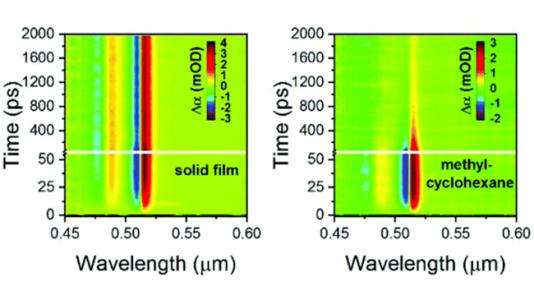
Scientific Achievement
Heat transfer across hybrid organic-inorganic interfaces was measured by infrared pump, electronic probe spectroscopy (IPEP) which does not use electronic excitation, thereby removing any measurement artifacts.
Significance and Impact
Matching vibrational and molecular structure of ligands with surrounding solvents allows for quicker cooling of colloidal nanocrystals, which has implications for heat management in areas such as thermoelectrics.
Research Details
- Femtosecond infrared pulses heat up organic ligands which transfer heat to attached inorganic nanoparticles, changing the bandgap on a 10 picosecond time-scale, followed by loss of heat to the surrounding solvent over hundreds of picoseconds.
- IPEP measurements were performed at CNM using ultrafast transient absorption spectroscopy.
This work was performed at the Center for Nanoscale Materials.
DOI: 10.1039/C9NR01473J
Argonne National Laboratory seeks solutions to pressing national problems in science and technology. The nation’s first national laboratory, Argonne conducts leading-edge basic and applied scientific research in virtually every scientific discipline. Argonne researchers work closely with researchers from hundreds of companies, universities, and federal, state and municipal agencies to help them solve their specific problems, advance America’s scientific leadership and prepare the nation for a better future. With employees from more than 60 nations, Argonne is managed by UChicago Argonne, LLC for the U.S. Department of Energy’s Office of Science.
The U.S. Department of Energy’s Office of Science is the single largest supporter of basic research in the physical sciences in the United States and is working to address some of the most pressing challenges of our time. For more information, visit https://energy.gov/science.